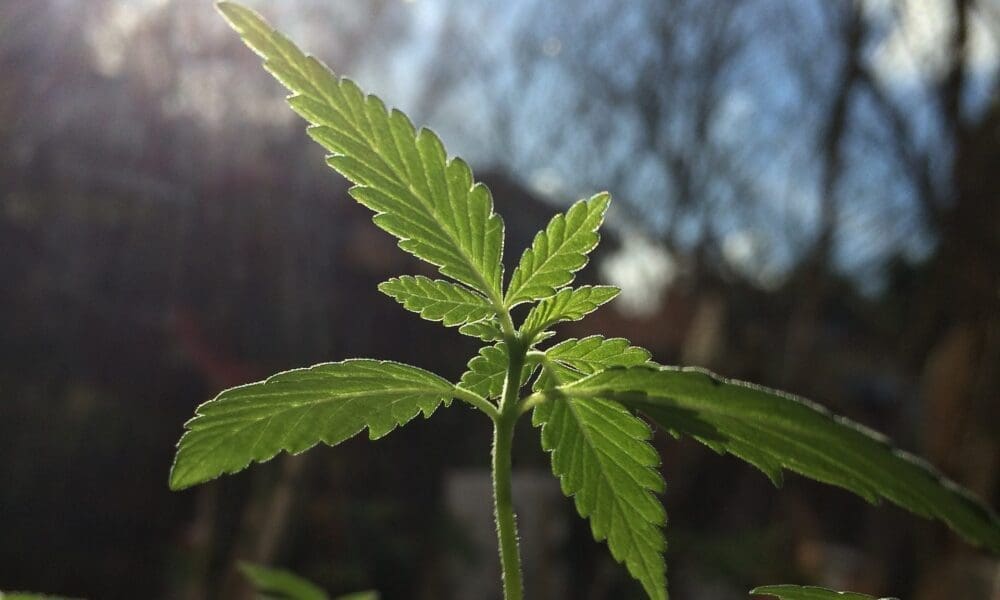featured
THE SUPER GROW ROOM (1983)
Published
12 hours agoon

Original publication: March 1983.
THE SUPER GROW ROOM
They’re the wave of the future— cost effective, secure and efficient.

American marijuana cultivators are the most sophisticated, scientific farmers in the world. In just a few years they have mastered the techniques of breeding, hybridization, sinsemilla cultivation and curing. They have doubled and redoubled the yield and potency of their crops. Although the media usually concentrates interest on outdoor “farmers,” most outdoor growers these days raise only their own stash, or operate in a limited area using a controlled environment—i.e., a grow room. The high cost of marijuana and the risk involved in its cultivation have constantly challenged the cultivator to develop techniques that use space most efficiently. The potential for a high profit has also given growers the incentive and ability to experiment, and nowhere is this more apparent than in the indoor garden.
I have seen the super grow rooms (SGRs), and I believe. These growers have succeeded. SGRs are based on the idea of limiting factors. The plant’s rate of metabolism, and subsequently its growth rate, maturation time and yield are governed by environmental conditions that act like links on a chain. Metabolism can proceed no faster than permitted by the limiting growing factors. There are five limiting factors: temperature, nutrients, water, light and carbon dioxide.
Super grow rooms meet such needs, automatically or semiautomatically, by using timers that regulate irrigation, lighting and C02 enrichment. Recently I had the pleasure of seeing two automated grow rooms. The first was lit naturally with supplemental lighting from metal halides. The corrugated sheet-steel roof had been replaced with Filon, a transparent corrugated plastic sheet made especially for greenhouses.
Exec, as he wishes to be called, grows uniform commercial crops which vary according to the season. He has two growing areas, a starting room and a main growing area. His spacious starting room is divided into a germination area, lit by fluorescents, and a seedling section lit by two halides. Seeds are germinated in 4″ pots and transplanted 10 days after germination into a 21/2-quart container.
Exec has designed a planting schedule that matches each plant variety’s seasonal habits with day length. Here is his planting and control schedule:
In late November, Exec starts equatorial seeds. He prefers a Nigerian-Santa Marta hybrid. He repots 10 days after germination, keeping the germination room lit 24 hours a day. The plants are removed to the large growing area about three and a half weeks after germination. This area is totally roofed with Filon, and has 10 halides for supplemental light. Total area is 1000 square feet.
At the time they are moved to the large growing area, the plants are repotted again, this time into 2-gallon containers. The lighting is set at 12 hours, to coincide with natural light. These lights are burned only when the sun is out, so that undue suspicion is not aroused by the lit roof.
To control the flowering period, Exec has strung rows of removable incandescents, having each 100-watt light bulb illuminating about 9 square feet. For the next three weeks he turns these lights on for 1 minute (the minimum time on his short-range timer) every 90 minutes. This prevents the plants from starting to flower—they sense the increasing number of hours of uninterrupted darkness. Around the middle of January he turns off the incandescents. A week later he turns the halides down to 10 hours, where they remain until the end of flowering. Exec claims to have had varieties that would not ripen until the light was down to 8 hours.
Around March 1 the new crop is planted. This time he uses either a Southern African-Afghani or Mexican hybrid. They are replanted around March 15 and then, around April Fool’s Day, they replace the last crop, which is ready to be harvested. Exec then cuts the plants up and hangs them to dry in his starting room, which he now keeps dark. He manicures them only after they are dry. Exec has a busy schedule transplanting the new residents of the growing area into 2-gallon pots. He keeps the halides on for 13-14 hours and then once again he uses his incandescents nightly, this time for two weeks, until about April 15, when he turns the lights down to 11 hours and covers the roof with long shades made from agricultural shading material. He manually opens and shuts the shades, closing them at dusk, as the lights go off, and opening them late in the morning as the lights come on. In late spring he sometimes uses only sunlight during the brightest part of the day.
On May 15 Exec plants another new crop. This time it is definitely an Afghani-Southern African, which flowers at 14-16 hours of light. By June 15 the Southern African-Mexican hybrid is ready, and the Afghani-Southern African are placed in the main garden.


Exec grows uniform commercial crops, which vary according to the season. He harvests over 500 plants four times each year.
They are given only a natural-light cycle, and the halides supplement the natural light only on cloudy days. On July 15 they are shaded, to put them into harvest cycle, receiving no more than 14 hours of light. The plants are ready by August 30, and Exec replaces them with a Northern Mexican-Kush cultivar, or sometimes an Afghani-Kush hybrid which he’d planted a month before. He uses flashing incandescents until September 30, when he lets the light cycle drop back to day length. The plants are ripe by December 15, a nice Christmas cheer. He gets four crops a year and uses a minimum of electric light, and is able to grow in a large area, arousing few suspicions regarding spinning electric meters.
Exec uses a propane heater during the cool months. This enriches the air with C02 while providing heat. Other times he enriches the air with C02 from a tank. During the hot months he uses a ceiling fan and several high-powered window fans, but at times the room gets a little too warm for optimal growth. Cannabis grows fastest when the temperature ranges between the 60s and 80s. When the temperature gets higher, photosynthesis stops; when it is lower, photosynthesis slows down.
Exec has about 500 plants per crop, and has no time to water them. Instead, he has a drip emitter attached to each container, and each day he waters his plants by turning on a valve for a few minutes. First he tests how much water the average plant needs. Then, using a simple formula—amount required divided by flow per hour multiplied by 60 —he arrives at the number of minutes needed for watering. His emitters flow at the rate of 1 gallon per hour (gph). If the plants require 8 ounces: 8 -r 128 x 60 = 3.7 minutes. When he is not around to take care of things manually, he estimates the plant needs and then sets his short-term timer, which regulates a solenoid valve.
He adds soluble hydroponic nutrients and other fertilizers and minerals to the water solution several times a month.
The second garden I visited, ministered by Elf, was lit totally by halides and sodium vapor lamps. Elf’s area totals about 225 sq. ft., of which 175 sq. ft. is growing space. He cultivates about 80 plants per crop and claims that he can grow five to six crops a year, but actually works at a more leisurely pace.
Elf also has a separate starting area. He can start a crop every two months, using the germination area for about one month before setting the plants in the main garden. Plants are started in 2 Vi-quart containers and transplanted when they are moved to IV2-gallon containers.
Sometimes he starts from clones, which takes longer than starting from seeds, but ultimately less effort since there are no males to deal with. Three weeks after entering the main growing area, the light cycle is reduced to 13 or 14 hours from constant. In six weeks the plants are ready to harvest.
Equatorial varieties take longer to mature, but Elf prefers them to the stuff that he sells, so he has a growing room for his own stash. It is stocked with exotics.
Elf ventilates the room, using two duct fans and open windows which are covered to seal in light. C02 is injected from a tank into all three rooms from a C02 tank on a timer.
Elf waters his plants by hand, using a 5-gallon container and a Vfe-gallon pitcher. At maturity the plants require about Vz gallon of water every four to seven days, depending on temperature. This saturates the container and partially fills the tray. Each container holds a mixture of vermiculite, perlite, Styrofoam and foam rubber. Each container sits in a saucer to prevent spillage. Plants that are bigger than most receive extra water between irrigations. Smaller plants receive less water each time. Watering takes less than an hour. He uses a combination of soluble fertilizers, and contends that his own urine, either fresh or fermented, is the best source of nutrients you can use. His plants were healthy and had no nutrient deficiencies. But the taste…

Author: mscannabiz.com
MScannaBIZ for all you Mississippi Cannabis News and Information.
You may like
-


ICE Raid Turns Violent at Camarillo Cannabis Farm
-


Massachusetts Cannabis Social Equity Trainings Set to Resume After Year-Long Delay
-


Plague in AZ; Hassayampa River bottom ‘chaos,’ ICE raids cannabis farm | FOX 10’s must-see stories
-


Massachusetts’s Social Equity Cannabis Program Is Back On Track After A Year On Pause
-


Weed near me: How are cannabis shops in Rockland, Westchester faring?
-


Is Cannabis Becoming A Serious Rival To Beer
featured
Massachusetts Cannabis Social Equity Trainings Set to Resume After Year-Long Delay
Published
58 minutes agoon
July 14, 2025
The Massachusetts Cannabis Control Commission (CCC) plans to resume the state’s cannabis social equity training program this fall after a year-long delay caused by budget constraints, the CommonWealth Beacon reports.
Regulators approved 229 individuals for the trainings last year, but the process halted abruptly after the Legislature failed to allocate proper funding. State officials now plan to resume the program for the approved applicants on September 8 and will begin accepting additional applicants starting August 1.
Passed by voters in 2016, the state’s cannabis legalization law requires a social equity program that includes cannabis industry trainings, guidance for navigating the industry’s many regulatory hurdles, networking opportunities for approved applicants, and fee waivers to help cannabis business owners or employees enter the industry, the report said.
The CCC’s Acting Chair Bruce Stebbins told the Beacon that he appreciated officials’ efforts to carry on the program despite funding-related uncertainties.
Kevin Gilnack, the deputy director of Equitable Opportunities Now, said in the report that while he appreciates the difficulties faced by regulators, “it’s definitely frustrating to those who were really eager to get into the industry and looking at this [training program] as their pathway into it.”
“I think the important thing is that we figure out a way to make sure that future social equity program participants aren’t held back by these funding challenges. It would be great to see the Legislature actually set up automatic funding so that regardless of what else is going on, social equity will remain a priority that actually gets fulfilled every year.” — Gilnack, to the Beacon
Meanwhile, Gov. Maura Healey (D) last year awarded 50 grants totaling $2,350,000 to cannabis social equity businesses through the state’s Cannabis Social Equity Trust Fund.

Author: mscannabiz.com
MScannaBIZ for all you Mississippi Cannabis News and Information.
featured
Massachusetts’s Social Equity Cannabis Program Is Back On Track After A Year On Pause
Published
2 hours agoon
July 14, 2025
“It’s definitely frustrating to those who were really eager to get into the industry and looking at this as their pathway into it.”
By Bhaamati Borkhetaria, CommonWealth Beacon
The Massachusetts Cannabis Control Commission’s (CCC) social equity program—which has been on pause for a year due to budget constraints—is back on track for the fall.
Last year, the commission accepted 229 individuals into the cannabis industry training program for individuals most impacted by the war on drugs, but said that the agency didn’t have funding from the Legislature to operate the program as promised. The course is aimed at providing industry training, technical assistance around regulatory requirements, networking opportunities and fee waivers for those impacted groups to make it easier for them to enter the industry as cannabis business owners or employees.
Now, with pressure from advocates to get the program restarted, CCC leadership says it is now kicking off on September 8 with the current round of applicants and will accept more applicants starting August 1.
The Legislature capped the agency’s budget at $19.88 million—about $10 million less than the commission’s $30 million budget ask for fiscal year 2026. This kicked off a back-and-forth between the commission’s leadership and lawmakers over whether the CCC is adequately funded to complete crucial IT infrastructure updates, hire for important positions and conduct public awareness campaigns.
Bruce Stebbins, the commission’s acting chair, said to CommonWealth Beacon after the commission’s public meeting on Thursday that he is excited for the social equity programming to begin again and that he is appreciative of the agency’s staff for working within the current budget to keep the process moving along.
“They’ve understood the constraints of the level [of] funding that we’ve gotten over the last couple of years, and I think they’ve pivoted effectively,” said Stebbins. “They’re trying to make changes so that the program remains open to everybody and everybody has access to the program material.”
The cohort that was accepted last summer was given access to virtual training on an online platform called TalentLMS, but didn’t receive the in-person instruction and networking opportunities that previous cohorts did. Starting in September, there will be updated courses on the platform and trainings offered through Zoom. The classes will be virtual in order to limit costs.
Many accepted individuals have been waiting for the programming to begin in earnest for over a year, expressing open disappointment with the delays.
“I understand the tensions around the budget and the fact that the Legislature has kept the commission on a pretty tight string, and that the commission has had to make tough choices, but it’s definitely frustrating to those who were really eager to get into the industry and looking at this as their pathway into it,” said Kevin Gilnack, deputy director of the cannabis advocacy group Equitable Opportunities Now, who was one of the applicants accepted in last year’s cohort.
Gilnack—who was once arrested for cannabis possession—said he is eager to take the business- and cannabis industry-specific classes offered by the program, so he can figure out if there is a viable path for him to enter the competitive industry.
Part of the pitch in the successful 2016 ballot measure for cannabis legalization in Massachusetts included assisting those harmed by the war on drugs to participate in the legal industry. The subsequent law legalizing cannabis and creating the CCC, passed by the Legislature in 2017, directs the commission to ensure full participation—still a somewhat ambiguous metric—in the industry by those disproportionately harmed by marijuana prohibition.
The commission often touts its work as a nationwide model, in part because of its social equity training program.
But the funding issues are not likely to resolve soon. Lawmakers have kept a critical eye on the turmoil and regulatory delays at the commission in the past two years. Issues include allegations of bullying at the agency, failure by the commission to collect over $500,000 in licensing fees and long delays in major regulatory changes. The House passed a cannabis reform bill on June 4 that would restructure the commission to a three-member body appointed solely by the governor as a way of addressing some of the agency’s leadership issues.
Gilnack’s group is advocating for a bill put forward by state Sen. Liz Miranda (D) of Boston, who co-chairs the Joint Committee on Racial Equity, Civil Rights and Inclusion. The bill would automatically set aside funding from cannabis tax revenue to go towards the social equity program, even if the Legislature chooses not to fully fund the commission through its ordinary process and without considering how the commission chooses to allocate its budget.
“I think the important thing is that we figure out a way to make sure that future social equity program participants aren’t held back by these funding challenges,” said Gilnack. “It would be great to see the Legislature actually set up automatic funding so that regardless of what else is going on, social equity will remain a priority that actually gets fulfilled every year.”
This article first appeared on CommonWealth Beacon and is republished here under a Creative Commons Attribution-NoDerivatives 4.0 International License.![]()

Author: mscannabiz.com
MScannaBIZ for all you Mississippi Cannabis News and Information.

The ground is shifting under the beer industry – and marijuana is a reason
Beer is the third most popular drink globally behind water and tea. But in the US, is cannabis becoming a serious rival to beer? According to recent research from investment bank TD Cowen, U.S. cannabis sales reached $29 billion in 2023, up from approximately $10 billion just five years earlier. That figure now represents about 11 percent of the total U.S. alcohol market, up from just 4 percent in 2018. Cannabis sales are projected to reach $37 billion by 2027, driven by increased legalization and changing social attitudes.
RELATED: The Connection Between Country Music And Cannabis
TD Cowen, which covers alcohol and cannabis as part of their portfolio, forecasts the number of monthly cannabis users will grow by 18 million in the next five years, while alcohol is expected to lose about 2 million regular consumers. They also forecast the number of monthly cannabis users will grow by 18 million in the next five years, while alcohol is expected to lose about 2 million regular consumers.

Independent reporting from the Financial Times supports this trend. In states where cannabis is legal, two-thirds of cannabis users reported drinking less alcohol, with beer the most affected category. A similar trend has been observed in Canada, where beer sales per capita dropped more than 2 percent annually following national legalization.
Some alcohol industry analysts are sounding the alarm. A Forbes article earlier this month linked the underperformance of alcohol stocks to growing health-conscious behaviors and increased cannabis use, particularly among younger adults seeking alternatives to traditional drinking.
Despite the shift in spending, beer remains a staple for many consumers. A recent analysis by YouGov and Google Trends reveals that Miller is the most popular beer in 30 states, including the Midwest and Southeast. Coors leads in eight states, including California, Texas, and Arizona, while Guinness is most searched in New Jersey, Georgia, and South Carolina. Also, still maintaining strong sales are Budweiser, Bud Light, Blue Moon, and Corona, although each holds a smaller share of state-level popularity.
RELATED: Cannabis Is Way Better And Safer Than A Honey Pack
This evolving consumer landscape suggests a long-term rebalancing of the alcohol and cannabis markets. Much of the shift is driven by younger Millennials and Gen Z, who increasingly prioritize wellness, moderation, and cannabis as a social alternative to alcohol. Industry watchers say beer companies may need to adjust—either by diversifying into cannabis-infused beverages or rethinking how they market to health-conscious consumers.
As more states move toward legalization and public sentiment shifts, the once-clear lines between the cannabis and alcohol industries are beginning to blur. Whether beer can hold its ground or cannabis continues to climb remains to be seen—but the competition is clearly underway.

Author: mscannabiz.com
MScannaBIZ for all you Mississippi Cannabis News and Information.

ICE Raid Turns Violent at Camarillo Cannabis Farm

Massachusetts Cannabis Social Equity Trainings Set to Resume After Year-Long Delay

Plague in AZ; Hassayampa River bottom ‘chaos,’ ICE raids cannabis farm | FOX 10’s must-see stories

Massachusetts’s Social Equity Cannabis Program Is Back On Track After A Year On Pause

Weed near me: How are cannabis shops in Rockland, Westchester faring?

Is Cannabis Becoming A Serious Rival To Beer

Federal Agency Cancels Marijuana Production Deal With University Of Mississippi, Ending Partnership That Lasted Half A Century

HYTN Secures Cannabis Drug License, Advancing Pathway for Prescription Cannabinoid-Based Medicines

What Happens After Adult-Use Legalization? Uruguay’s 10-Year Cannabis Report Card

Pew Poll: Few Americans Support Feds’ Blanket Prohibition of Marijuana

Worker Killed, Hundreds Arrested During ICE Raids on California Cannabis Farms

Taylor Police Department working to remove unauthorized marijuana content posted to Google page

The recreational use of marijuana on tribal lands in Mississippi could be legalized in near future

New Bipartisan Marijuana Legalization Bill In Pennsylvania House Comes As Separate Senate Proposal Gains Momentum

Federal authorities arrest 319 illegal aliens in major ICE raid at Cali cannabis farm

Feel the (Cannabis Leaf Margin) Burn

WATCH: Seized marijuana destroyed | The Manila Times

THE SUPER GROW ROOM (1983)

Day after federal immigration raid at Glass House Farms in Camarillo, family members search for missing loved ones

Senate Committee Voices Concern About ‘Misleading’ Cannabis Marketing And Promotes Psychedelics Research After Passing Hemp Ban

Federal officials announce 200 workers arrested in Carpinteria, Camarillo farm raids

New details revealed about suspects arrested during ICE raid at Cannabis farm

White House cannabis rescheduling meeting (Newsletter: July 14, 2025)

361 arrested in immigration sweeps at 2 Southern California cannabis farms, feds say

Alert: Department of Cannabis Control updates data dashboards with full data for 2023

Connecticut Appoints The US’s First Cannabis Ombudsperson – Yes there is a pun in there and I’m Sure Erin Kirk Is Going To Hear It More Than Once!

5 best CBD creams of 2024 by Leafly

Free delta-9 gummies from Bay Smokes

EU initiative begins bid to open access to psychedelic therapies
New Study Analyzes the Effects of THCV, CBD on Weight Loss

Mississippi city official pleads guilty to selling fake CBD products

May 2024 Leafly HighLight: Pink Runtz strain

Curaleaf Start Process Of Getting Their Claws Into The UK’s National Health System – With Former MP (Resigned Today 30/5/24) As The Front Man

5 best autoflower seed banks of 2024 by Leafly

Horn Lake denies cannabis dispensary request to allow sale of drug paraphernalia and Sunday sales | News

Discover New York’s dankest cannabis brands [September 2024]

Press Release: CANNRA Calls for Farm Bill to Clarify Existing State Authority to Regulate Hemp Products

Local medical cannabis dispensary reacts to MSDH pulling Rapid Analytics License – WLBT

Nevada CCB to Accept Applications for Cannabis Establishments in White Pine County – “Only one cultivation and one production license will be awarded in White Pine County”

5 best THC drinks of 2024 by Leafly

6 best CBD gummies of 2024 by Leafly

The Daily Hit: October 2, 2024

5 best delta-9 THC gummies of 2024 by Leafly

Weekly Update: Monday, May 13, 2024 including, New Guide for Renewals & May Board meeting application deadline

People In This State Googled ‘Medical Marijuana’ The Most, Study Shows

Thailand: Pro-cannabis advocates rally ahead of the government’s plan to recriminalize the plant

PRESS RELEASE : Justice Department Submits Proposed Regulation to Reschedule Marijuana

Press Release: May 9, STIIIZY and Healing Urban Barrios hosted an Expungement Clinic & Second Chance Resource Fair
Trending
-

 California Cannabis Updates1 year ago
California Cannabis Updates1 year agoAlert: Department of Cannabis Control updates data dashboards with full data for 2023
-

 Breaking News1 year ago
Breaking News1 year agoConnecticut Appoints The US’s First Cannabis Ombudsperson – Yes there is a pun in there and I’m Sure Erin Kirk Is Going To Hear It More Than Once!
-

 best list12 months ago
best list12 months ago5 best CBD creams of 2024 by Leafly
-

 Bay Smokes1 year ago
Bay Smokes1 year agoFree delta-9 gummies from Bay Smokes
-

 Business10 months ago
Business10 months agoEU initiative begins bid to open access to psychedelic therapies
-

 cbd1 year ago
cbd1 year agoNew Study Analyzes the Effects of THCV, CBD on Weight Loss
-

 Mississippi Cannabis News1 year ago
Mississippi Cannabis News1 year agoMississippi city official pleads guilty to selling fake CBD products
-

 California1 year ago
California1 year agoMay 2024 Leafly HighLight: Pink Runtz strain

